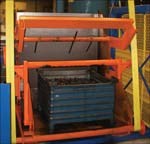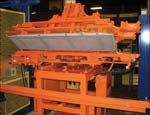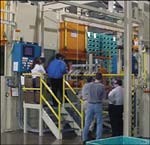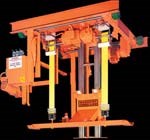Automating the Barrel Finishing Process
Unique and innovative finishing system automation continues to provide manufacturers and platers with the most effective kind of productivity improvement…
Barrel finishing systems are becoming increasingly sophisticated in order to provide the high levels of productivity, reliability and consistency of quality output that is being required and demanded by industry today. Most of these systems have included custom-designed layouts, hoists, track and frame structure, process tanks, rectifiers, dryers, load and unload automation, accessory equipment, filtration, ventilation, waste treatment, process control, cycle design, installation and startup. Now, new advances in barrel load and unload automation have been developed to further improve productivity and part quality, reduce required manpower and improve ergonomics. In addition, new computer controls, which monitor and control all aspects of the process, now feature custom-designed interfaces with part recipe control, detailed process report monitoring and advanced process cycle options. Many of these new features are also being incorporated into upgrades of existing lines.

|
| Figure 1: A key automation component of a barrel finishing system is the hoist, featuring a center-mounted guide column and a belt lift system. |
Hoists
The conventional automated hoist (Figure 1), which features overhead track and a center-guided belt-lift system, has become the workhorse of the industry, providing productive, reliable, low maintenance and easily serviceable operation. Thousands of these hoists are in use on finishing lines doing electroplating, e-coating, phosphating, chromating, plating on plastics and other wet dip processes.
Typically, these hoists include a simple, rugged, cart weldment that rides on overhead-supported structural channel track. The cart supports the lift and transfer gearbox/motor units, the lift and transfer shafts, the center-mounted stainless steel lift guide column, the limit switch address package and the manual control pendant. The lift shaft rotates the belt spools to wind-up the polyester belts, which raise and lower the lift arm that carries the barrels and work. The new polyester belts provide significantly longer life than the traditional wire cables. Wireless remote controls are increasingly being used in place of the hoist-mounted control pendants for easier manual hoist control.
Hoists can be positioned with two-speed motors or with variable speed drives, with their position measured by laser linear encoders, rotary encoders, or limit switches, all depending on the speed and transfer smoothness required.

|
| Figure 2: A high-capacity, round polypropylene barrel with tab-locking covers. |
Barrels
Barrel capacity is important in establishing system productivity. Standard, rugged round polypropylene plating barrels with tumbling ribs (Figure 2) can reliably handle loads up to 1,000 lbs, and stainless steel phosphating barrels can handle up to 6,000 lbs. New barrel perforation sizes and shapes have been developed to minimize dragout while maximizing plating efficiency. Barrel cover designs have improved for both easier handling and for tighter fits to prevent trapping of parts.
Loading and Unloading
In terms of automation, the greatest productivity gains for metal finishing systems are made in the material handling process by getting parts into and out of the system faster and with less manpower. Typical systems used to automate the handling of parts into and out of finishing barrels include an automated shuttle, tote box dumper, load chute, vibratory feeder and load scale. In operation, once the tote box is placed into the dumper, the system will perform all of the material handling physical labor.

|
| Figure 3: A double-acting tote box dumper with a single belt lift, capable of rotating the tote box a full 180 degrees for a complete dump without trapping any parts. |
However, with the widespread implementation of ISO and QS quality standards, automation designs have required new concepts and techniques to provide more gentle part handling as well as the elimination of any possibility of part mixing from one lot to another. This has been addressed with new, patented tote box dumpers that feature a double-acting concept with an inner hopper and a main hopper, connected with a simple linkage mechanism, enabling the tote box to be rotated a full 180-degrees, or completely upside down (Figure 3). It uses a single belt lift drive that can be combined with a variable speed drive for custom-controlled dumping speed that is sometimes needed to properly handle a wide variety of parts. This dumper provides a solution to eliminating the part mixing that can occur when all of the parts are not initially emptied out of a tote box.
Automated Cover Handling System
Valuable processing time and labor reduction can also be enhanced by automating the placing and removal of finishing barrel covers. This has been addressed with a new automatic cover handling system that can be integrated into an automated barrel system that uses either polypropylene or stainless steel barrels.

|
| Figure 4: An automatic cover handler system holding the single piece 75-lb cover from a stainless steel phosphating barrel. |
In operation, the shuttle transfers a full barrel of processed parts to the automatic cover handling system, where the system then locates itself against the barrel and rotates the barrel into proper position for cover removal. Automated slides remove the single-piece cover and hold it, while the shuttle transfers the barrel to unload the processed parts and to be loaded with raw parts. The barrel is then returned to the cover handler where the cover is replaced and the barrel is then transferred for processing. The single piece cover features a patented lever-spring locking mechanism and slide tabs that enable the cover to be removed and replaced automatically, while retaining the cover and maintaining a tight fit on the rotating barrel during processing, preventing any part entrapment (Figure 4).
Computer Control
Modern computer controls integrate all aspects of automated systems, including the hoist positioning, load and unload equipment, accessory equipment, recipe management, process cycling and management reporting, with the operator managing graphically displayed information on a touch screen computer interface. Typical controls can include recipe management with bar codes, part history reports, temperature control, rectifier control, level control, pH control, chemical feed, diagnostics and maintenance schedules.
A very important aspect of automated system productivity is the process cycles. Properly designed and optimized cycles are the key to maximizing system throughput. Engineered cycles can be simple fixed batch cycles for running the same basic recipe at a pre-determined rate, or they can be complex random loading cycles for running a range of different recipes on a fully random sequence while maintaining a full pre-determined production rate with consistent process times.
Noise Reduction
Acoustics have become a significant factor in the design of some automated finishing lines, with sound level ratings being included in the machine specifications for a growing number of production facilities. Special system designs are needed to achieve required sound levels as low as 85 decibels (dBA), particularly for barrel line applications where metal parts are being dumped and conveyed via metal containers throughout the process.

|
| Figure 5: An 85-dBA sound enclosure with automatic doors covering a phosphate system’s complete automatic load and unload station. |
One method of containing noise is to enclose the entire loading and unloading area with a custom-designed fabricated structure built to specific wall thickness dimensions, using specific materials and ensuring that there are no air gaps (Figure 5). For automated systems, these structures include automatic sliding doors for barrel shuttle and fork lift entry and exit. A method of dampening noise, particularly with steel barrels, is to load and unload the barrels while they are submerged in solution. Yet another method is to apply sound absorbing material to the outside of tote box dumper hoppers, load chutes, and other flat metal components, which reduces the airborne structural vibrations that transmit the noise.
Summary
In the processing sector of manufacturing the objectives for a designer and builder of metal finishing systems continues to be the same—help maximize productivity improvement, maintain consistent and documented high quality standards for the end product and provide equipment that is reliable and environmentally friendly for the operators and workers. Much of the success in achieving these objectives has been the result of new developments in automation concepts and techniques, many of which have been described here.
Related Content
Top Shop Leader Focuses on Its People as Key to Success
Twin Cities job shop, Avtec, was named a Top Shop for the third time in 2022, due in no small part to its commitment not only to the work it produces but to those who produce it — its employees.
Read MoreTake Full Advantage of Industry Events
As travel plans ramp up for the year, what industry events will you attend? Products Finishing offers a quick look at some of the upcoming opportunities for 2024.
Read MoreConveyors and Paint Systems
Choosing the right conveyor system, coating technology, and ancillary equipment.
Read MoreMasking Solutions Provider CFS Dramatically Expands Capabilities and Capacity
Custom Fabrication & Supplies (CFS) completed a new plant expansion packing 10 times the capacity into twice the space. It dramatically enhances the supplier’s custom capabilities to provide extremely precise and cost-effective masking solutions.
Read MoreRead Next
Episode 45: An Interview with Chandler Mancuso, MacDermid Envio Solutions
Chandler Mancuso, technical director with MacDermid Envio discusses updating your wastewater treatment system and implementing materials recycling solutions to increase efficiencies, control costs and reduce environmental impact.
Read MoreEducation Bringing Cleaning to Machining
Debuting new speakers and cleaning technology content during this half-day workshop co-located with IMTS 2024.
Read MoreDelivering Increased Benefits to Greenhouse Films
Baystar's Borstar technology is helping customers deliver better, more reliable production methods to greenhouse agriculture.
Read More


























